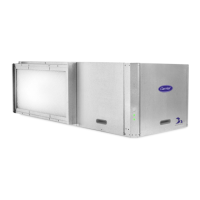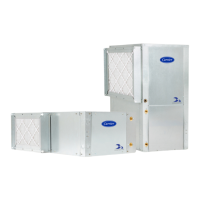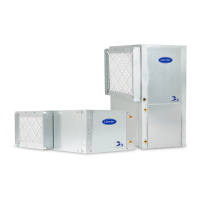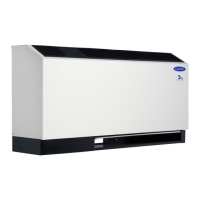45
Table 9 — Troubleshooting
LEGEND
PROBLEM POSSIBLE CAUSE SOLUTION
ENTIRE UNIT DOES
NOT RUN
Power supply off Apply power, close disconnect
Blown fuse
Replace fuse or reset circuit breaker. Check for correct fuses.
Voltage supply low
If voltage is below minimum voltage specified on unit data plate, contact local power
company.
Thermostat
Set the fan to "ON", the fan should run. Set thermostat to "COOL" and lowest tem-
perature setting, the unit should run in the cooling mode (reversing valve energized).
Set unit to "HEAT" and the highest temperature setting, the unit should run in the
heating mode. If neither the blower or compressor run in all three cases, the thermo-
stat could be mis-wired or faulty.To ensure mis-wired or faulty thermostat verify 24
volts is available on the condensing section low voltage terminal strip between "R"
and "C", "Y" and "C", and "O" and "C". If the blower does not operate, verify 24 volts
between terminals "G" and "C" in the air handler. Replace the thermostat if defective.
BLOWER OPERATES
BUT COMPRESSOR
DOES NOT
Thermostat Check setting, calibration, and wiring.
Wiring
Check for loose or broken wires at compressor, capacitor, or contactor.
Safety controls Check Complete C/Deluxe D board red default LED for Blink Code
Compressor overload open If the compressor is cool and the overload will not reset, replace compressor.
Compressor motor grounded
Internal winding grounded to the compressor shell. Replace compressor. If compres-
sor burnout, install suction filter drier.
Compressor windings open
After compressor has cooled, check continuity of the compressor windings. If the
windings are open, replace the compressor.
UNIT OFF ON
HIGH PRESSURE
CONTROL
Discharge pressure too high
In "COOLING" mode: Lack of or inadequate water flow. Entering water temperature
too warm. Scaled or plugged condenser.
In "HEATING" mode: Lack of or inadequate airflow. Blower inoperative, clogged filter
or restrictions in ductwork.
Refrigerant charge The unit is overcharged with refrigerant. Recover refrigerant, evacuate and recharge
with factory recommended charge.
High pressure Check for defective or improperly calibrated high pressure switch.
UNIT OFF ON
LOW PRESSURE
CONTROL
Suction pressure too low In "COOLING" mode: Lack of or inadequate air flow. Entering air temperature too
cold. Blower inoperative, clogged filter, or restrictions in ductwork.
In "HEATING" mode: Lack of or inadequate water flow. Entering water temperature
too cold. Scaled or plugged condenser.
Refrigerant charge The unit is low on refrigerant. Check for refrigerant leak, repair, evacuate and
recharge with factory recommended charge.
Low pressure switch Check for defective or improperly calibrated low-pressure switch.
UNIT SHORT
CYCLES
Unit oversized Recalculate heating and or cooling loads.
Thermostat
Thermostat installed near a supply air grille, relocate thermostat. Readjust heat
anticipator.
Wiring and controls
Loose connections in the wiring or a defective compressor contactor.
INSUFFICIENT
COOLING OR
HEATING
Unit undersized Recalculate heating and or cooling loads. If excessive, possibly adding insulation
and shading will rectify the problem.
Loss of conditioned air
by leaks
Check for leaks in ductwork or introduction of ambient air through doors or windows.
Airflow Lack of adequate airflow or improper distribution of air. Replace dirty filter.
Refrigerant charge Low on refrigerant charge causing inefficient operation.
Compressor Check for defective compressor. If discharge is too low and suction pressure is too
high, compressor is not pumping properly. Replace compressor.
Reversing valve
Defective reversing valve creating bypass of refrigerant from discharge to suction
side of compressor. Replace reversing valve.
Operating pressures
Compare unit operating pressures to the pressure / temperature chart for the unit.
TXV/Capillary Tube Check for possible restriction or defect. Replace if necessary.
Moisture, noncondensables The refrigerant system may be contaminated with moisture or noncondensables.
Recover refrigerant, evacuate and recharge with factory recommended charge.
Note: a liquid line drier may be required.
LED — Light Emitting Diode
TXV — Thermostatic Expansion Valve
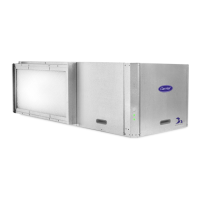
